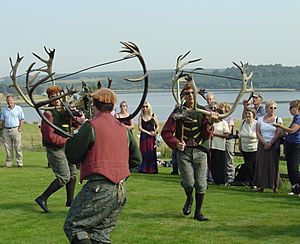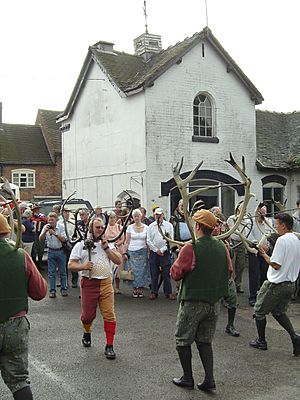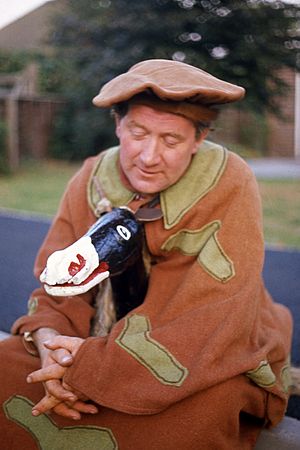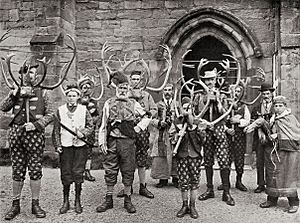Abbots Bromley Horn Dance facts for kids
The Abbots Bromley Horn Dance is a very old English folk dance. It likely started way back in the Middle Ages. This special dance happens every September in Abbots Bromley, a small village in Staffordshire, England. Today, the dance features real reindeer antlers, a hobby horse (a fake horse you "ride"), a character called Maid Marian, and a Fool.
Contents
History of the Horn Dance
We don't have any written records of the Horn Dance before 1686. That's when a book called Natural History of Staffordshire by Robert Plot mentioned it. However, we know a hobby horse was used in Abbots Bromley as early as 1532. It's possible the horn dance was also part of the tradition back then, but wasn't written about.
Scientists used a method called radiocarbon dating to study the antlers used in the dance. They found that the antlers are from the 11th century!
Where Did It Come From?
Some people think the use of antlers means the dance started with the Anglo-Saxons. They believe it might have come from pagan times. It could have been linked to the powerful Mercian kings, who lived about 15 miles away in Tamworth. These kings owned huge hunting lands around Abbots Bromley.
The idea is that a royal forester (someone who looked after the forest) would organize special rituals. These were like sympathetic magic to make sure there were lots of animals to hunt each year. This tradition might have continued even after people became Christian. It slowly became a way for villagers to show they had the right to hunt.
Even after the lands were given to Burton Abbey in 1004, a forester still worked there. By the 1500s, this job was passed down through families. The "Forester of Bentylee" title belonged to the Bentley family. They kept the dance going until 1914. Then, it was passed to the Fowell family, who still help run it today.
Some experts point out that while the antlers are from the 11th century, reindeer had already disappeared from England and Wales by then. This means the antlers must have been brought here from places like Scandinavia. This makes some people think the dance might have started with just the hobby horse. The horn part could have been added later.
The Dance Event
The Horn Dance brings many visitors to the village. On "Wakes Monday," which is the day the dance happens, there's also a fair on the village green. You can see Morris dancing and other fun things. The village has had the right to hold this fair since 1221.
When and Where It Happens
The Horn Dance takes place on Wakes Monday. This is the day after Wakes Sunday, which is the first Sunday after September 4th. In the past, the dance sometimes happened on Twelfth Day (in January), Christmas Day, or New Year's Day. But since 1660, it has mostly been on Wakes Monday.
The dance begins at 8 a.m. with a special blessing service at St Nicholas's Church. This is where the horns are kept when they're not being used. The dancers start on the village green. Then, they walk out of the village, but stay within the local area, going to Blithfield Hall. This hall is owned by the Bagot family.
The dancers return to the village in the early afternoon. They visit local pubs and houses. Finally, around 8 p.m., the horns are brought back to the church for a special evening service.
The Dancers
There are 12 dancers in total. Six of them carry the heavy antlers. They are joined by a musician playing an accordion (it used to be a violin). Other characters include Maid Marian (a man dressed as a woman), the Hobby-horse, the Fool (or Jester), a young person with a bow and arrow, and another young person with a triangle. Traditionally, all the dancers were male. However, in recent years, girls have carried the triangle and the bow and arrow.
Until 1914, all the dancers were from the Bentley family. The dance then passed to the Fowell family, who are related to the Bentleys. They still have a connection to the dance today, even if they don't live in the village anymore. They sometimes let visitors join in if they ask nicely. They also often invite musicians and others to take part.
The Antlers
The horns are six sets of reindeer antlers. Three are white and three are black. In 1976, a small piece of one antler was tested. It was found to be from around the year 1065. Since there were no reindeer in England at that time, the horns must have been brought from Scandinavia.
The six sets of horns used to be kept in the Village Hall. This building is now a pub called the Goat's Head Inn. Later, they were kept in the tower of St Nicholas's Church. Between the two World Wars, special brackets were put in the Hurst Chapel inside the church. Here, the horns were placed on wooden heads carved by local artists. The horns used today were brought from Constantinople (now Istanbul) by Lord Paget in the 1700s. He was the British Ambassador to the Ottoman Empire. However, there might have been horns used long before these ones. The heaviest horn weighs about 16 kilograms (36 pounds). One of the horns has 36 points!
The antlers are attached to small wooden heads. Since 1981, the horns have belonged to the Abbots Bromley Parish Council. There is also another set of antlers, from red deer. These are used when the dancers perform outside the village, which they often do.
The Dance Itself

The dance steps are quite simple. This is because the antlers are very heavy, large, and can be hard to move with.
In 1911, a folk dance expert named Cecil Sharp described the dance. He said there were ten people: six dancers with horns, Maid Marian, the Hobby-horse, the boy with the bow and arrow, and the Fool. He saw them dancing in a single line, moving in a circle. Today, the dancers usually perform in two columns.
This is a bit different from the 12 dancers mentioned earlier.
The Music
Cecil Sharp wrote down two versions of the music for the dance. In his 1911 notes, he said he saw the dance performed to "Yankee Doodle" and another simple tune. However, in 1912, he wrote that he received a different version of the music. This came from a Mr. J. Buckley, who had written it down in 1857 or 1858. Mr. Buckley got the music from William (or Henry) Robinson, a wheelwright from Abbots Bromley. Robinson was known as the only person who could play the Horn Dance tune on his fiddle. This version has three parts and is in a different rhythm.
Abbots Bromley Horn Dance on Stamps
In 2019, Royal Mail (the UK postal service) released a special set of stamps. They were called UK Weird and Wonderful Customs. The Horn Dance from Abbots Bromley was one of the customs featured! Other customs on the stamps included:
- Bog snorkelling at Llanwrtyd Wells
- The World Gurning Championship at Egremont
- Up Helly Aa in Lerwick
- Burning the Clocks in Brighton
- 'Obby 'Oss festival in Padstow
- Samhain Celtic festival (Halloween) at Derry
- Cheese-Rolling at Cooper's Hill
See Also




